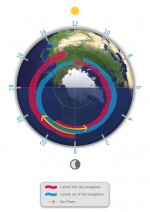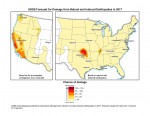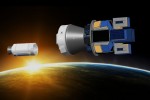
Tuesday, April 11th, 2017
Earth’s magnetic field is like a huge cocoon, protecting the planet from cosmic radiation and charged particles found in solar wind. European Space Agency (ESA) Swarm satellites are recording details about one of the most difficult to observe layers of Earth’s magnetic field—as well as the magnetic history imprinted on Earth’s crust. Most of Earth’s

Monday, April 3rd, 2017
The CanX-7 nanosatellite built by Space Flight Laboratory (SFL) at the University of Toronto Institute for Aerospace Studies validated real-time detection and tracking of aircraft by a satellite in low-Earth orbit. The next mission phase will begin in early May 2017 with deployment of drag sails developed by SFL to accelerate the deorbiting of small

Thursday, March 30th, 2017
Headquartered in Beaumont, California, Bogh Engineering is a 3rd generation family owned construction and engineering company with 65 employees. It focuses on construction of public schools, and is currently working on 14 job sites including building the 1.4 million square foot Indio High School. “90% of our business is focused on schools because we understand

Tuesday, March 28th, 2017
Information from the European Space Agency (ESA) magnetic field Swarm mission led to the discovery of supersonic plasma jets high up in Earth’s atmosphere that can push temperatures up to almost 10,000 degrees Celsius. Presenting these findings at the Swarm Science Meeting in Canada, scientists from the University of Calgary explained how they used measurements

Tuesday, March 21st, 2017
Just a little more than two weeks after its Feb. 19, 2017, launch on a SpaceX Falcon 9/Dragon spacecraft, the Stratospheric Aerosol and Gas Experiment III (SAGE III) is now safely installed on the outside of the International Space Station, where it will monitor ozone and aerosols in Earth’s upper atmosphere. In a highly choreographed
Tuesday, March 14th, 2017
Detecting and predicting lightning just got a lot easier. The first images from a new instrument onboard NOAA’s GOES-16 satellite are giving NOAA National Weather Service forecasters richer information about lightning that will help them alert the public to dangerous weather. The first lightning detector in a geostationary orbit, the Geostationary Lightning Mapper (GLM), is

Tuesday, March 14th, 2017
Aeromon, a Finnish cleantech startup that utilizes its innovative analytics platform and mobile sensors to flexibly map emissions in real-time, successfully demonstrated the effectiveness of drone-mounted platforms for measuring industrial emissions. A pilot program at the Ämmässuo waste treatment centre (operated by the Helsinki Region Environmental Services Authority HSY, Finland) compared historical data captured using

Tuesday, March 7th, 2017
New U.S. Geological Survey (USGS) maps identify potential ground-shaking hazards in 2017 from human-induced and natural earthquakes in the central and eastern United States (CEUS). This is the second consecutive year both types of hazards are forecasted, as previous USGS maps only identified hazards from natural earthquakes. This research recently was published in Seismological Research

Tuesday, February 28th, 2017
In the second half of 2018, the European Space Agency (ESA) Vega small launcher is set to demonstrate its extended capability to deploy multiple light satellites using its new versatile Small Satellites Mission Service (SSMS) dispenser. This demonstration provides the first of the launch opportunities under the new Light satellite, Low-cost Launch opportunity (LLLor L3)

Tuesday, February 21st, 2017
The emerald golfing greens have seen better days. According to the U.S. National Golf Foundation, the number of players has steadily declined from over 30 million in 2005 (pre-recession) to 24.7 million today; 680 US and 158 Canadian courses have closed. “Golf course owners are working smarter to manage resources like water and labor more